Y-12 Blog
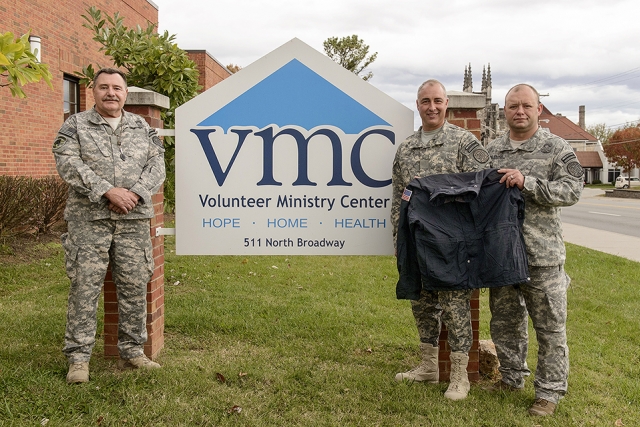 Veterans and current Y‑12 Security Police Officers delivered former uniform coats to the Volunteer Ministry Center.
Veterans and current Y‑12 Security Police Officers delivered former uniform coats to the Volunteer Ministry Center.
A few years ago, Y-12’s Protective Force changed from solid gray uniforms to their current digital camouflage gear. The old uniforms—some of which were actually new, with tags still on—were considered excess and likely headed toward a landfill. Around that same time, Y‑12 was collecting outerwear for its annual United Way Coat Drive. That gave Security Police Officer John Fellers an idea.
He recalled, “I knew we were asking for coat donations at the same time I saw our uniform coats headed to a landfill, so I asked the obvious question, ‘Can’t we donate these?’”
If only it were that simple. With no clear mechanism in place for donating unneeded government materials to community agencies, Y‑12 United Way chair Yvonne Bishop barely knew where to begin. “We had to make a lot of calls to try and learn how to get this done,” Bishop said. “We essentially had to invent the process as we went.”
After a lengthy series of delays, Bishop got the approval she needed from NNSA’s Albuquerque Complex. But the work was far from done. The coats would need to be surveyed to ensure they were free of any contaminants, then cleaned and sorted.
“Several of our Radiological Control technicians volunteered their own time to survey and green‑tag all 85 coats and warm liners, and other employees volunteered to remove the sewed‑on company patches,” Bishop said.
For cleaning and sorting, Y‑12 worked up a contract with the Michael Dunn Center, a Morgan County United Way agency that provides services and employment opportunities for people with developmental disabilities. The center’s employees washed the coats and sorted them by size.
Finally, the coats were ready for their final destination: the Volunteer Ministry Center in downtown Knoxville. For years, Y‑12’s coat drive has benefitted VMC’s efforts to end and prevent homelessness.
To make the donation of these unique coats even more special, the United Way committee worked with VMC to ensure the coats would go to homeless veterans. They were handed out shortly after Veteran’s Day.
“It took some time, but I’m thrilled we were able to make it happen,” Bishop said. “Our employees showed their true caring nature by volunteering their time for this effort, and we were able to give work to one United Way agency and really nice coats to another United Way agency.”
Fellers appreciated the United Way team’s willingness to stick with the effort despite the obstacles. “I’m really glad we continued to push to make this happen, even when many thought we should give up or just do something easier like donate money,” he said. “We helped make more than 80 homeless veterans a little more comfortable this winter.”
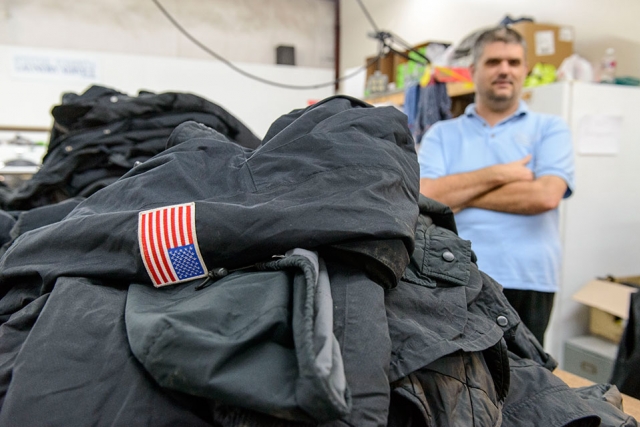 Employees at the Michael Dunn Center cleaned the coats.
Employees at the Michael Dunn Center cleaned the coats.
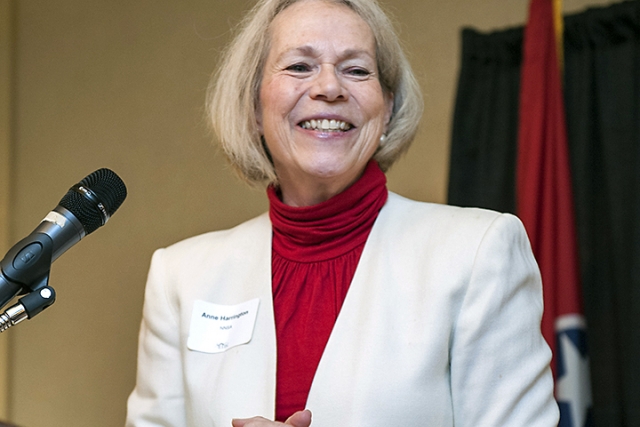 NNSA Deputy Administrator for Defense Nuclear Nonproliferation Anne Harrington addresses the East Tennessee Economic Council.
NNSA Deputy Administrator for Defense Nuclear Nonproliferation Anne Harrington addresses the East Tennessee Economic Council.
Making the world a safer place. That is the message Anne Harrington delivered to the East Tennessee Economic Council about NNSA’s role in nuclear nonproliferation.
Harrington, Deputy Administrator for Defense Nuclear Nonproliferation for the National Nuclear Security Administration, was the featured speaker at the annual ETEC awards luncheon in December at the Doubletree Hotel in Oak Ridge.
Prior to her speech, Harrington visited Y-12 and heard from project managers about their work in research reactor fuel development and highly enriched uranium minimization. Y-12 officials said she was very engaging and stated, “When I think uranium, I think Y-12 and Oak Ridge.”
Harrington, who has been at her post since 2010, was introduced at the luncheon by CNS President and Chief Executive Officer Jim Haynes. Haynes described her as a woman of great accomplishment and whose work is vital to the security of the country.
In her address, Harrington emphasized the importance of Y-12 and ORNL to the mission of nonproliferation. She pointed out that today the “threat is less about nuclear war,” and more about terrorists gaining access to materials to develop an “improvised weapon.”
Harrington said, “One aspect of our mission to prevent nuclear terrorism is eliminating highly enriched uranium in all civilian applications, including in research reactors and isotope production facilities.”
As an example, she pointed to heart scans – used by more than 50,000 people every day, which are made possible with the isotope Molybdenum 99, orMo99. She described how experts at Y-12 are involved in the transfer of low enriched uranium to Mo99 producers in Australia, Belgium, South Africa and the Netherlands as well as working with producers to convert production from HEU to low-level enriched uranium.
“While it may not always be easy to see the results of the work you and your neighbors are part of, know that without it, the world would be much more dangerous place without you,” she said.
Despite the success of such programs, Harrington warned that the work is not done. “Our mission is enduring,” she said. “There still exist vast stocks of HEU and other dangerous nuclear and radiological materials to address.”
Harrington’s hope for Y-12 and Oak Ridge National Laboratory’s work in nonproliferation is that it is a “partnership” for the long term. “Because that is certainly how we look at this relationship,” she said.
Harrington’s speech was part of an agenda that included the annual announcements of the Postma Young Professional Medal and the Muddy Boot Award, which recognizes individuals who, through their work, make Oak Ridge a better community.
This year’s Muddy Boot winners were Dan Hurst, CEO and founder of Strata-G and former legislator, businessman and current Deputy to the Governor Jim Henry.
Ann Weaver, facilities engineer at ORNL, was awarded the Postma Award, which recognizes outstanding young professionals.
Also recognized at the luncheon was Atomic Trades and Labor Council President Steve Jones, who is retiring from Y-12 after more than 40 years on the job. He is also ending his position with the ATLC after successfully negotiating a new 5-year contract. “It’s time to take a breather,” said Jones.
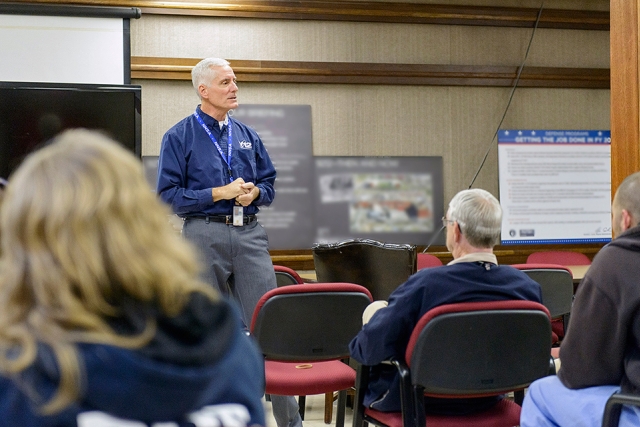 NNSA Uranium Program Manager Tim Driscoll speaks with the One-Metric-Ton Challenge team in Building 9212. The team has undertaken an extensive dedicated maintenance effort to improve metal production equipment reliability and reduce unexpected down time, with an end goal of significantly increasing purified metal production by fiscal year 2017.
NNSA Uranium Program Manager Tim Driscoll speaks with the One-Metric-Ton Challenge team in Building 9212. The team has undertaken an extensive dedicated maintenance effort to improve metal production equipment reliability and reduce unexpected down time, with an end goal of significantly increasing purified metal production by fiscal year 2017.
Last year, NNSA Uranium Program Manager Tim Driscoll challenged Consolidated Nuclear Security, LLC to develop a clear plan to produce 1000 kg per year of purified uranium metal, a significant increase over goals from recent years. Rather than attack the challenge from the production side by increasing shifts and demanding more throughput, the One-Metric-Ton Challenge team approached it from a different angle.
The team — consisting of members from Engineering, Production, Program Management and Maintenance — proposed that their response to the challenge focus first on the biggest obstacle to producing any amount of purified metal at all: the equipment.
“Building 9212 has had issues with maintaining process equipment in recent years,” Senior Technical Advisor Susan Kozemko said. “The equipment often breaks down, causing unscheduled production shutdowns and excessive downtime for repairs.”
Given the lack of redundant equipment and the batch nature of processing operations, combined with so many unexpected shutdowns and delays, all equipment availability has been utilized for production runs. The tradeoff from this approach is a backlog of more than 200 corrective maintenance work orders related to 9212’s metal production equipment.
Portions of the facility will need to remain operational until 2025, after the Electrorefining project in Building 9215 and the new Uranium Processing Facility have come on-line. “We realized that much of the equipment in 9212 needs to be maintained for up to 10 more years of operating life,” Kozemko said.
To make that happen, in October 2015, Y-12 established a maintenance crew, consisting of nine full-time maintenance craft and two work planners, dedicated solely to reducing the 9212 maintenance backlog and ensuring the equipment remains viable as long as possible. Additional supporting resources, including a radiological control technician and an issuing authority, should be in place by the end of the year to complete the dedicated maintenance crew.
The crew will take an outage approach to executing maintenance activities. Instead of addressing issues individually and only as problems appear, the crew will isolate entire systems at a time, and during that outage, address all possible corrective and preventive maintenance issues before returning the system to operation.
“The first outage is nearing completion, and the second is underway,” Kozemko noted. “All maintenance outage activities are coordinated with the facility’s production goals and with other facility activities to provide the least possible impact to ongoing work.”
Additionally, through corporate reach-back, Lockheed Martin experts are evaluating the maintenance efforts and will provide recommendations on critical spares to be established; preventive maintenance program enhancements; consolidation of equipment; and other improvements in maintenance strategies, supporting systems, procedures and practices.
With the focus now on improving system reliability, the original One Metric Ton Challenge has been redefined as the “Purification Challenge.” Ultimately, the team hopes to significantly reduce the number of unscheduled outages and unanticipated downtime for repairs. That, in turn, should allow for sustained operation and increased throughput, with plans to significantly increase purified metal production and meet Driscoll’s challenge by FY2017.
On a recent visit to Y-12, Driscoll stopped by to chat with the team and highlight the importance of their task. “He emphasized the importance of the team’s efforts to place our uranium product in a safer form — purified metal — thereby reducing safety and mission risk for Y-12 as a whole,” Kozemko said. “He also relayed the need to provide a stockpile of material to help mitigate risks associated with new processes, new facilities and future mission requirements.”
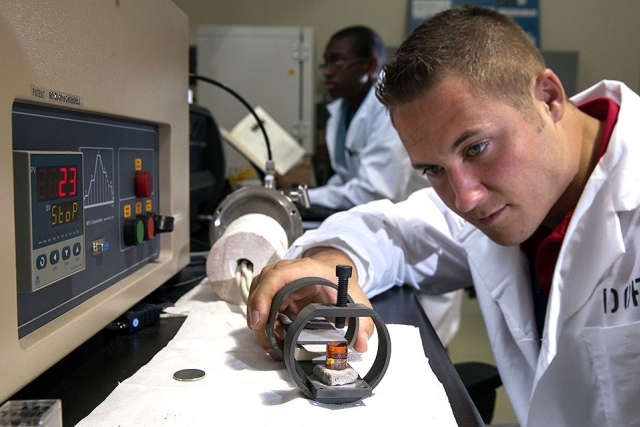 Dustin Giltnane, a University of Tennessee graduate student, is in the CNS pipeline and will become a full time employee in May 2016, upon completion of dual master’s degrees.
Dustin Giltnane, a University of Tennessee graduate student, is in the CNS pipeline and will become a full time employee in May 2016, upon completion of dual master’s degrees.
CNS invests in people — sometimes before they join the payroll as full‑time employees. Dustin Giltnane is a prime example of that healthy pipeline at work.
He graduated from the University of Tennessee with a bachelor’s degree in nuclear engineering and was working on dual master’s degrees (an MBA with a focus in entrepreneurship and engineering with a focus in nuclear security) when the opportunity arose for him to work with Ashley Stowe, CNS’s Physical Sciences functional manager and Technology Fellow emeritus. While working on a Joint Assignment Agreement with UT’s nuclear engineering department, Stowe recognized Giltnane’s abilities, energy and creativity and was able to expand his CNS neutron detection research team to include the native Tennessean. Giltnane is now working on novel solid state neutron detectors.
Plant Directed Research and Development funds made it possible to add researchers to the CNS staff without expanding Stowe’s budget. Through strategic subcontracts, Stowe also added team members from two other nearby universities — Fisk and Vanderbilt.
“University partnerships are good for CNS. Professors provide continuity and identify the best and brightest students, who help boost our productivity and creativity,” said Ben Stephens of Program Integration. “Our hope is that CNS and these students mutually invest in and engage each other for the long term.”
“I came to Y‑12 as a graduate assistant and then moved into a leadership role, mentoring Maxx Jackson, an Alabama A&M summer student, and taking responsibility for the thermal conductivity transient instrument, or TCT, which measures critical thermal parameters of materials,” said Giltnane.
One challenge in fabricating high‑quality radiation detection crystals is growing large crystals without defects. The research Giltnane is conducting will provide thermal conductivity data needed to improve crystal growth modeling. He is paired with a radiation detection company, supplying new data that will improve a materials detection tool and boost national security.
“Dustin has been a great addition to the team,” said Stowe. “He is technically sound, but his natural leadership and business curriculum provide a unique combination of discipline and innovation within the project. He’s an excellent mentor and has a bright future here at Y‑12.”
Giltnane initially studied nuclear engineering because of his interest in the environmental aspects. He’d read extensively about weather and global changes and that sold him on it. “I started out on the nuclear plant side but found it to be a little dull,” he said. “I am happy to work at Y‑12 to find a balance and more in‑depth science. It’s a much wider spectrum, and I like the nonproliferation and research side.”
What’s Giltnane’s long‑term career goal? “I’d like to move up through Y‑12 into a research position and see where that takes me. I’m interested in nuclear nonproliferation policy and counterterrorism, which is kind of an extension of nuclear security,” he said.
And in his spare time, Giltnane co‑owns a business, Guru Skins, where he and two fellow UT MBA students create customized ski, skateboard, wakeboard and snowboard graphics and vinyl covers. “We won a competition at UT to get our initial seed money, and it took off from there. Since then, we’ve won other competitions and have earned a total of $21,000,” he said. The team recently placed third (out of 14 teams) in the SEC Symposium in Atlanta.
“We work with artists all over the world and pay royalties for every product that sells with their designs. Our vinyl covers allow sport enthusiasts to protect their boards and change the look cost‑effectively while expressing their individual styles.” The idea for the graphics company came naturally as all three business owners are “boarders,” which gave them insight to identify the industry need as well as their niche market.
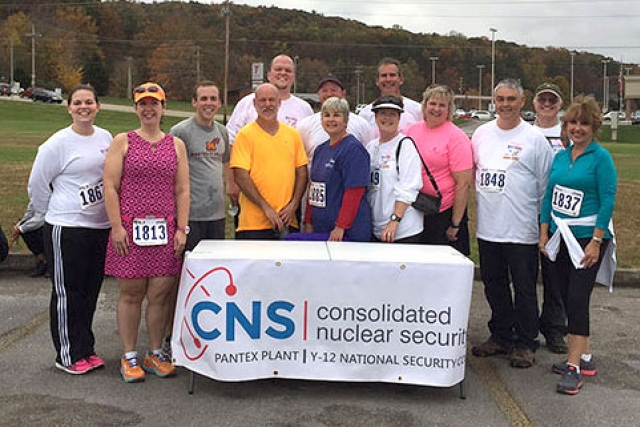 Y-12’s team for the Volunteer Ministry Center 5K.
Y-12’s team for the Volunteer Ministry Center 5K.
Run VMC is not a new rap group, but the 5K to benefit the Volunteer Ministry Center is a wrap.
Y-12’s team consisted of more than 20 employees and retirees. The race began and ended at Hardin Valley Elementary, and several team members received accolades. Travis Wilson from Mission Support/Infrastructure was the overall winner with a time of 16:48. Other team members who finished in the top 20 included Tom Berg of Technology Development/Transfer, Jeff Bock of Mission Assurance/Quality, who also won in his age group, and Chris Gilliam of Mission Engineering.
VMC is a Knoxville-based interfaith agency that was founded in 1987. The agency’s mission is to facilitate permanent supportive housing for those who are homeless and to provide services to prevent homelessness.
The center helped 87 people get into permanent housing last year, and 34 of those were chronically homeless. VMC also helped more than 700 individuals/families remain in their homes last year and provided dental care for more than 1,000 patients through the dental clinic.
Y-12 employees and retirees have a long-standing relationship with VMC and support the center by volunteering time and donating supplies.
The team included Kevin Alexander, Temitope Asemota, Vicki Belt, Tom Berg, Jeff Bock, Peggy Campbell, Linda Cantrell, Leslie Daugherty, Doug Davies, Karen Dixon, Mo Dixon, Jay Everett, Chris Gilliam, Justin King, Kathryn King, Rob Kring, Rikki Martz, Diane McDaniel, Mari Kaye Monday, Karen Smith, Harold Waddle, Elain Warren and Travis Wilson.
